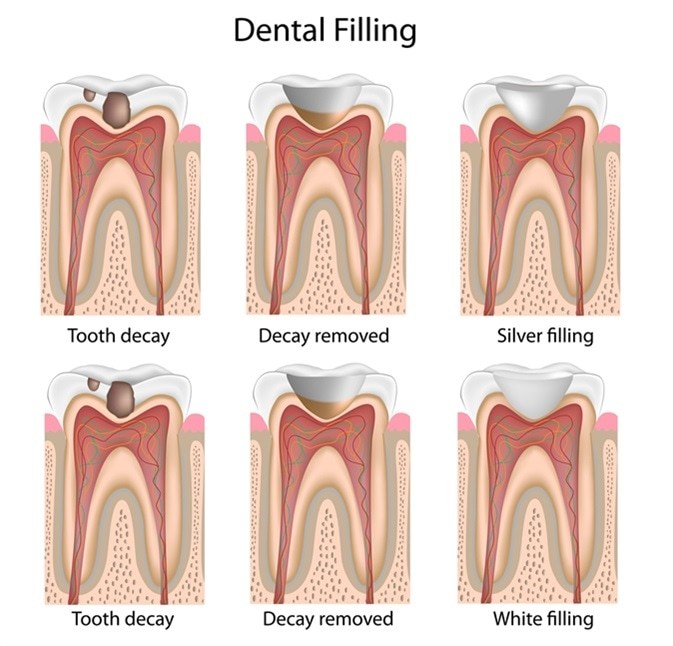A dental filling is a restorative procedure which repairs fractures to your teeth or if tooth decay has impacted the tooth. Fillings can also help smooth uneven tooth surfaces and aid both biting and chewing.
Dental filling procedure
The key steps of a dental filling include:
- Administer a numbing local anaesthetic to the area around an affected tooth.
- Prepare the damaged or decayed tooth, as well as its immediate surroundings, for the filling and restoration process. This is likely to involve the removal of damaged or decayed areas.
- Cleanse the area of both bacteria and debris through the use of an acid gel.
- Apply the filling material into the cavity or treatment area. A composite filling requires the affected tooth to be isolated, thus preventing moisture from entering the bonding process. Adhesives are used to achieve this and the composite material is hardened by use of a special bonding light.
- The repaired tooth is then polished.

When considering the use of composite, porcelain, or amalgam fillings, you and your dentist should consider a range of key areas. Among these are:
- Appearance: porcelain and composite fillings offer a more natural tooth-like appearance. Less preparation, such as the removal of healthy tooth structure, is required for porcelain or composite fillings.
- Safety: these composite or porcelain fillings have the potential advantage of not containing mercury and other metals, which might lead to sensitivity or toxicity. Some patients are sensitive to certain metals and do report a metal taste in their mouth after use of an amalgam. It should be noted that no research carried out to date has shown any risks in having mercury as a component of amalgam fillings.
- Long-lasting: in the past, composite or porcelain fillings were not as durable as amalgam. Recent manufacturer improvements have greatly improved the strength of composite resins; these can now be used for all teeth, including molars. Composites can also offer the benefit of less preparation for the tooth and may not weaken the tooth as much as the preparation for an amalgam filling might. That said, amalgam fillings do still have the proven potential to last longer, up to 12 years or so, compared to either porcelain or composite alternatives, which have a lifespan of 5-7 years. Of course, this longevity does also depend on your own commitment at home to effective oral hygiene and tooth care. This should include twice-daily brushing using fluoride toothpaste and daily interdental brushes or flossing. And don't forget those regular check-up and cleaning visits to your dentist and hygienist!
- Procedure time-frame: Porcelain and composite fillings require both a higher level of technique and additional equipment. Patients should always check that their chosen dentist has achieved the level of post-graduate education to effectively refine their specific skills in this area. Time-wise, this also means that porcelain and composite filling procedures can take up to 50% more time to complete compared to a more straight-forward amalgam alternative.
The costs of dental fillings
As previously mentioned, composite fillings require more complex procedures and sophisticated equipment, and the materials themselves are more expensive. If you are considering porcelain or composite fillings, be aware that many dental insurance companies do not cover the additional costs associated with these procedures - so do check.
Various other factors will be part of the cost calculation. These include whether single or multiple tooth surfaces need to be treated, who is performing the procedure, the size and location of their surgery and the associated costs. As previously mentioned, the level of insurance cover you hold will also be a vital factor.
Because of the better appearance of composite fillings, patients do often later return and ask for their amalgam fillings to be changed. This is worth remembering when making an initial cost-based decision.
As a guide, each amalgam filling often costs in the $110-200 range, and resin-based composites cost between $135-240, depending on the number of tooth surfaces to be covered.






